The ceasefire in Gaza was meant to offer a moment of relief. Yet reality on the ground tells a different story. On Friday, Israel transferred 30 bodies of Palestinian detainees back to Gaza, even as new Israeli strikes killed three Palestinians and raised fresh concerns about the durability of the ceasefire agreement.
The bodies were transported through the Kerem Shalom crossing before being taken to the Nasser Medical Complex in Khan Younis, where families and medical staff gathered in somber anticipation. For many, the return represents both closure and trauma.
Disturbing Signs of Abuse Reported
Medical examination teams say the bodies arrived in conditions consistent with physical abuse and inhumane treatment. According to medical officials:
Some bodies were blindfolded or bore marks consistent with restraints
Several showed bruising, burns, and missing limbs or teeth
Many had begun decomposing, suggesting delayed release
Palestinian authorities assert that many of the deceased had been detained without formal charges, under Israel’s administrative detention system. This has reignited long-standing accusations of systematic abuse and torture inside Israeli detention centers.
Friday’s transfer brings the number of Palestinian bodies returned during the current exchange arrangement to 225, according to Gaza’s Ministry of Health.
Ceasefire Deal: Progress Overshadowed by Violence
The return of detainees’ remains is part of a U.S.-brokered ceasefire and exchange arrangement, in which:
Hamas released 20 Israeli captives alive
Israel freed nearly 2,000 Palestinian detainees
Both sides agreed to return bodies of those killed during captivity
The remains of 28 Israeli captives are expected to be recovered
Hamas has so far returned 17 Israeli bodies, with three additional remains undergoing forensic verification in Israel following Friday’s handover.
At the same time, Hamas and Red Cross personnel have been searching destroyed neighborhoods and collapsed buildings in southern Gaza for remains of those killed in earlier Israeli bombardments. Aid workers warn that the scale of devastation and ongoing strikes continue to impede recovery efforts.
New Air Strikes Raise Fears of Ceasefire Breakdown
Despite the ceasefire announcement, Israeli military operations continue across parts of the Gaza Strip. Local sources confirmed:
Location | Incident |
|---|---|
Shujayea, Gaza City | One Palestinian killed, another critically wounded by Israeli fire |
Jabalia Refugee Camp | Palestinian killed by artillery shelling |
az-Zahra, Central Gaza | Body recovered from beneath destroyed home |
Khan Younis | Buildings struck by warplanes |
The Gaza Ministry of Health reports that dozens of Palestinians have been killed since the ceasefire came into effect, calling into question the durability and sincerity of the truce.
For civilians, the line between war and ceasefire remains perilously thin. Many say the current situation feels less like peace and more like a temporary pause in a cycle of violence.
Humanitarian Aid Enters Gaza, But Insufficient for Survival
A limited convoy of humanitarian aid trucks entered Gaza Friday, but residents and relief groups say the assistance remains far below the minimum required to sustain the population. Critical shortages continue in:
Food supplies
Medical equipment and medicines
Fuel for hospitals and shelters
Construction and shelter materials
Humanitarian workers say conditions in northern Gaza are especially dire, with famine-like levels of hunger and widespread displacement.
“People are exhausted, hungry, and waiting for real relief,” one humanitarian coordinator said. “A ceasefire means nothing if families cannot eat, find shelter, or access medical care.”
Diplomatic Discussions Intensify
International pressure is mounting to secure a more durable arrangement. Turkish Foreign Minister Hakan Fidan announced an upcoming meeting of global diplomats to review the ceasefire’s status and explore the creation of a stabilization and monitoring force for Gaza.
Former Israeli minister Yossi Beilin suggested that Prime Minister Benjamin Netanyahu is unlikely to abandon the ceasefire agreement while under direct U.S. pressure, though political fractures inside Israel remain visible.
Israeli Detention System Under Scrutiny
In a separate development, Israel dismissed its top military legal officer, Yifat Tomer-Yerushalmi, after footage surfaced allegedly showing sexual assault against a Palestinian detainee in the Sde Teiman detention facility.
Human rights organizations have repeatedly accused the facility of systematic torture and abuse. The Israeli military says it has opened investigations into several allegations, though rights groups note a long history of limited accountability and closed cases.
A Ceasefire in Name, Turmoil in Reality
For families still searching rubble for loved ones, for those awaiting the return of missing relatives, and for displaced civilians living without basic necessities, the ceasefire has delivered little sense of safety.
Bodies continue to come home. Air strikes continue to fall. Aid remains restricted. And Gaza continues to navigate the space between temporary calm and renewed devastation.
As one resident told local media:
“A pause in fighting is not peace. Peace is when people come home alive, not in body bags.”
Takeaways:
Israel returned 30 bodies of Palestinian detainees to Gaza, with medical teams reporting signs consistent with torture and severe mistreatment.
New Israeli strikes killed at least three Palestinians, raising concerns over the stability of the current ceasefire.
The returns are part of a prisoner and captive exchange deal, which has seen 225 Palestinian bodies returned and 20 Israeli captives released so far.
Humanitarian aid remains restricted, with Gaza residents facing severe shortages of food, medicine, fuel, and shelter materials despite the truce.
International pressure is increasing as foreign ministers plan talks on securing the ceasefire and investigating abuse allegations in Israeli detention facilities.

